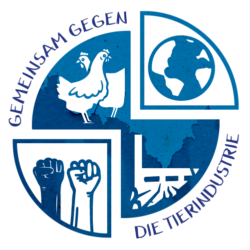Taken from Tierfabriken Widerstand.
Cattle are used for milk and meat production.
In most conventional farming systems, “dairy cows” spend their lives in narrow stalls, sometimes in continuous tethering. Here, too, typical species behaviour is practically impossible. By breeding for the highest possible milk production – which is on average twice as high today as it was 50 years ago – and due to the way the cows are kept, they are susceptible to numerous diseases. Many suffer from inflammation of the udder (mastitis), and joint and hoof damage are also common.
In order to give milk, a cow has to first give birth to a calf. The amount of milk is highest in the first few weeks after birth and then decreases continuously. To get the highest yield, cows on dairy farms are pregnated about once a year.
Shortly after the cow gives birth, the calf is taken away from her and kept separately, for example, in a so-called calf igloo, where they are fed a milk substitute while the milk of the cow is taken for human consumption. The separation of calf and cow is very stressful for both. The cows often call out for their child for days and the calves develop behavioural disorders. In the first few weeks of life, the horns on the calves‘ head are often burnt off using a rod to prevent the cattle from injuring each other or the farmer with the horns later on. The procedure is allowed to be performed without anaesthesia and entails considerable pain. The male calves are then fattened for the purpose of meat production, while the females are either fattened or become “dairy cows” like their mothers.
Sources:
- Die Haltung in Laufställen ohne Weidezugang wird vom Lobbyverein „Fördergemeinschaft Nachhaltige Landwirtschaft“ als artgerecht bezeichnet. (Vgl. die Broschüre „Verantwortungsbewusste Rinderhaltung“, zu beziehen www.fnl.de. Gesetzlich vorgeschrieben sind bei der Haltung in Ställen mind. drei Quadratmeter Platz pro 650-Kilo-Tier. Die Anbindehaltung soll auslaufen, wird aber voraussichtlich im Rahmen von Ausnahmeregelungen noch einige Jahre lang erlaubt bleiben.
- Wenn Rinder die Gelegenheit dazu haben, legen sie viele Kilometer am Tag zurück, bilden stabile soziale Gruppen und pflegen individuelle Bindungen. (Vgl. Hoy, Nutztierethologie, S. 97 und 83-89).
- Siehe z. B. das „Wissenschaftliche Gutachten über die allgemeinen Auswirkungen landwirtschaftlicher Betriebssysteme auf Wohlbefinden und Krankheiten von Milchkühen“ von der Europäischen Behörde für Lebensmittelsicherheit (efsa), Gremium für Tiergesundheit und Tierschutz, Frage-Nr. Q-2006-113, veröffentlicht im Juni 2009 (in Zusammenfassung zu finden hier).
- Vgl. Hoy, Nutztierethologie, S. 101.
- Vgl. Tierschutzgesetz § 5, Abs. 3; A.-V. Mang u.a., „Schmerzmanagement bei der Enthornung von Kälbern“, in: Deutsche Veterinärmedizinische Gesellschaft e. V., Tagung der DVG-Fachgruppe „Tierschutz“, S. 183-195, hier S. 184 [1] Der Text auf dieser Seite ist angelehnt an und teilweise identisch mit dem zuvor veröffentlichten Text von Friederike Schmitz: „Tierethik – Eine Einführung“, in dies. (Hg.): Tierethik, Berlin 2014.
